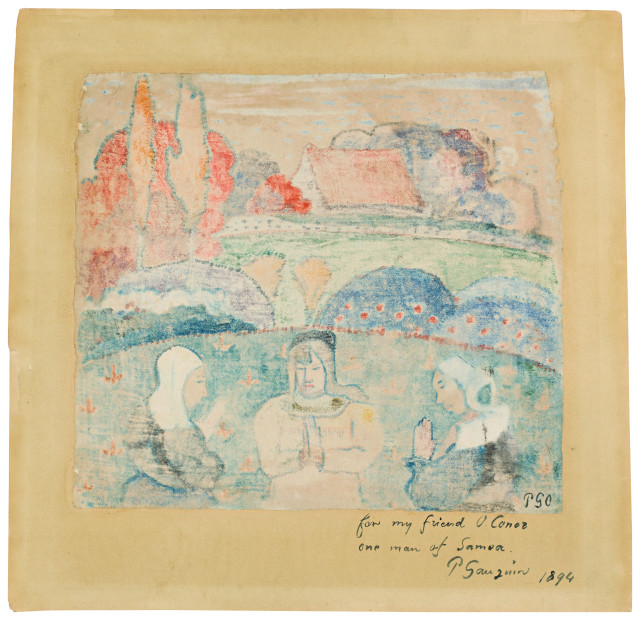- EN
Log in
- Live Auctions
- Past auctions
- More
- Gallery
- Art Dealing
- Publishing
- Kornfeld today
- The Story of Kornfeld
- Information




Paris 1848 - 1903 Hiva-Hoa (Marquesas)
1894
Monotype in colours on wove paper (papier vélin), glued to support by the artist
27,5x30 cm, drawing, with slightly different margins – 37,5x38 cm, cardboard
Monogrammed "PGO" in brush in black at lower right in the depiction, signed and dated "P Gauguin 1894" in brush in black at lower right on the backing within the dedication
Richard S. Field, Paul Gauguin, Monotypes, Philadelphia 1973, no. 25, reprod.
Gift from Paul Gauguin to Roderick O'Conor 1894
Auction Hôtel Drouot, Paris, 6 and 7.2.1956, cat. no. 17
Marvin Small Collection, New York
Collection Ira Gale, London
Private collection Switzerland
Philadelphia 1973, Philadelphia Museum of Art, Paul Gauguin, Monotypes, cat. no. 25, reprod. – Additionally full page reprod. in colours on pag. 14, as one of the most important coloured monotypes of the whole oeuvre
Chicago 1988, The Art Institute, The Art of Paul Gauguin, cat. no. 191
Paris 1989, Galerie national du Grand Palais, Paul Gauguin, cat. no. 191
Fresh in colours and clean, in good condition, laid down by the artist on brownish cardboard and dedicated on the backing in brush in black, signed and dated "for my friend O Conor / one man of Samoa. / P Gauguin 1894". Underlay with slight light margin in the passepartout cut-out
Between his two stays in the South Seas, Gauguin stayed in Paris in 1893/94 and during this time created, among other things, the 10 woodcuts that were intended as illustrations for his planned publication Noa Noa. In May 1894 he travelled to Pont-Aven in Brittany and met, among others, the Englishman Robert Bevan and the Irish painter Roderick O'Conor, to whom he dedicated the present work "for my friend O'Conor". Roderick O'Conor (1860-1940) stayed in Pont-Aven from 1883. Financially independent, he bought paintings by Gauguin, Cézanne, Bonnard, Manet, Renoir, Séguin and Toulouse-Lautrec. - Other monotypes, but not of the same importance, went to Edgar Degas, Aristide Maillol, Alexis Rouart and Francisco Durrio
For the present work, Gauguin took the central figure of the 3 praying Breton women from the oil painting Bretonne en prière, painted in Pont-Aven or Paris in 1894 (Wildenstein 1964, no. 518). The monotypes, especially coloured ones, are of the greatest rarity in the trade, as they are a special printing technique in which only one copy can be printed. Field was only able to find 139 monotypes in Gauguin's entire oeuvre, which was created between 1894 and 1902.
1894
Monotypie in Farben auf Velin, vom Künstler auf Unterlage aufgeklebt
27,5x30 cm, Zeichnung, Ränder leicht unterschiedlich – 37,5x38 cm, Unterlagekarton
Unten rechts in der Darstellung in Pinsel in Schwarz monogrammiert "PGO", rechts unten auf der Unterlage im Rahmen der Dedikation in Pinsel in Schwarz signiert und datiert "P Gauguin 1894"
Richard
Geschenk von Paul Gauguin an Roderick O’Conor 1894
Auktion Hôtel Drouot, Paris, 6. und 7.2.1956,
Slg. Marvin Small, New York
Slg. Ira Gale, London
Privatsammlung Schweiz
Philadelphia 1973, Philadelphia Museum of Art, Paul Gauguin, Monotypes,
Chicago 1988, The Art Institute, The Art of Paul Gauguin,
Paris 1989, Galerie national du Grand Palais, Paul Gauguin,
Farbfrisch und sauber, gut in der Erhaltung, vom Künstler auf bräunlichem Karton aufgelegt und auf der Unterlage in Pinsel in Schwarz dediziert, signiert und datiert "for my friend O Conor / one man of Samoa. / P Gauguin 1894". Unterlage mit leichtem Lichtrand im Passepartout-Ausschnitt
Zwischen seinen beiden Aufenthalten in der Südsee hielt sich Gauguin 1893/94 in Paris auf und schuf während dieser Zeit u.a. die 10 Holzschnitte, welche als Illustrationen für seine geplante Publikation «Noa Noa» gedacht waren. Im Mai 1894 reiste er in die Bretagne nach Pont-Aven und traf dort u.a. den Engländer Robert Bevan und den irischen Maler Roderick O’Conor, dem er das vorliegende Werk dediziert hat "for my friend O'Conor". Roderick O’Conor (1860-1940) hielt sich von 1883 an in Pont-Aven auf. Finanziell unabhängig kaufte er Bilder von Gauguin, Cézanne, Bonnard, Manet, Renoir, Séguin und Toulouse-Lautrec. - Weitere Monotypien, aber nicht von der gleichen Wichtigkeit, gingen an Edgar Degas, Aristide Maillol, Alexis Rouart und Francisco Durrio. Für das vorliegende Werk hat Gauguin die mittlere Figur der 3 betenden Bretoninnen dem Ölbild «Bretonne en prière» entnommen, welches 1894 in Pont-Aven oder Paris entstanden ist (Wildenstein 1964, Nr. 518). Die Monotypien, vor allem farbige, sind im Handel von grösster Seltenheit, da es sich dabei um eine besondere Drucktechnik handelt, bei der nur ein einziges Exemplar gedruckt werden kann. Field konnte im gesamten Œuvre Gauguins, zwischen 1894 und 1902 entstanden, nur gerade 139 Monotypien nachweisen





